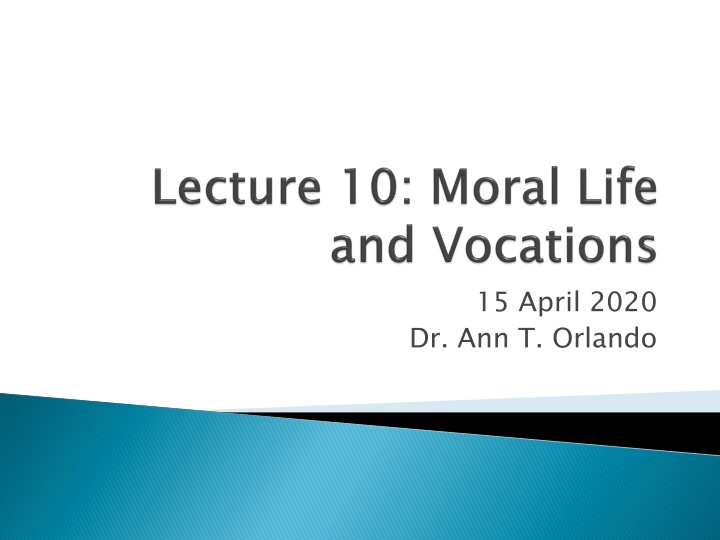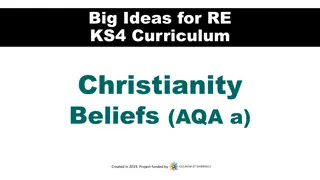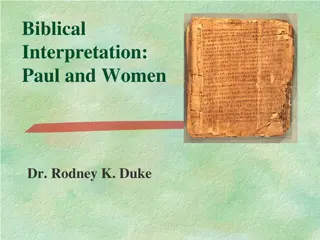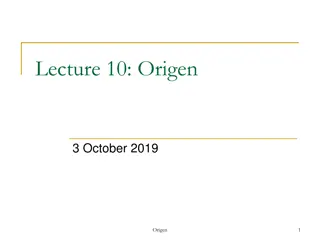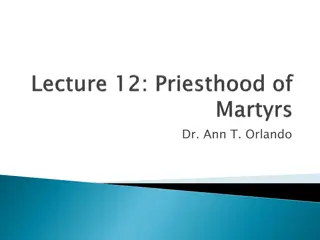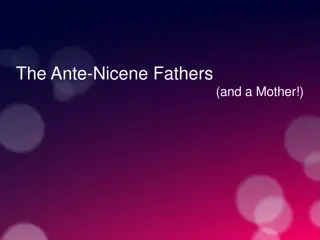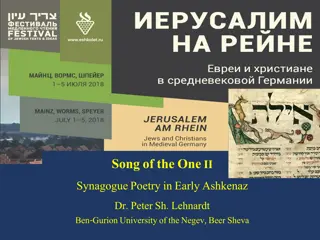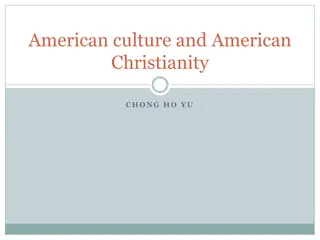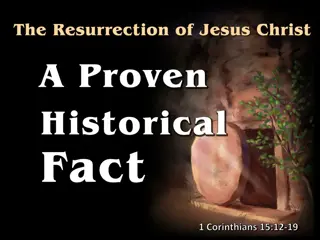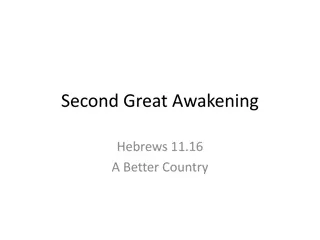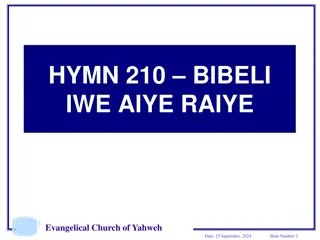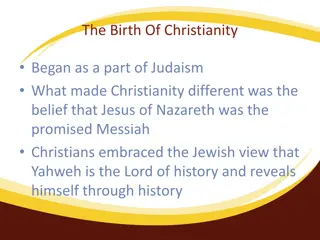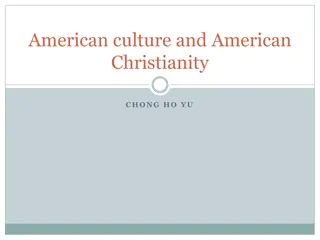Martyrdom and Evangelical Counsels in Early Christianity
Explore the significance of martyrdom and evangelical counsels in early Christianity, delving into the challenges surrounding celibacy versus marriage, the heroism of martyrs, and the debate on poverty, chastity, and the place of marriage in the Church. Discover the stories of martyrdom, the guidance of the Holy Spirit, and the evolving understanding of sacrificial living in the Christian faith.
Download Presentation

Please find below an Image/Link to download the presentation.
The content on the website is provided AS IS for your information and personal use only. It may not be sold, licensed, or shared on other websites without obtaining consent from the author.If you encounter any issues during the download, it is possible that the publisher has removed the file from their server.
You are allowed to download the files provided on this website for personal or commercial use, subject to the condition that they are used lawfully. All files are the property of their respective owners.
The content on the website is provided AS IS for your information and personal use only. It may not be sold, licensed, or shared on other websites without obtaining consent from the author.
E N D
Presentation Transcript
15 April 2020 Dr. Ann T. Orlando
Why celibacy v. marriage becomes an issue in the 4thC Jerome s Letter to Eustochium On Goods of Marriage On Holy Virginity On Continence On Marriage and Desire I.1-23
The heroic witness unto death formed the fundamental way in which the Church understood herself before 312 The sacrifice of the martyrs was often written in imitation of Jesus passion and death And since sacrifice is the definitive priestly act, so martyrs by their self-sacrifice are priests But acts of the martyrs often filled with Eucharistic references, thus emphasizing their priestly sacrifice See especially Martyrdom of Polycarp Willingness to suffer martyrdom is the ultimate sign of a Christian Regardless of marital status Regardless of social position
Recounts martyrdom of a group of young Christians c 203 Some parts of story written by Perpetua while in prison, then redacted by Tertullian Significant scholarly debate concerning language of origin: Greek or Latin Recounts how the direct action of the Holy Spirit guides and sanctifies Perpetua and her companions The witness of their sacrifice is given equal status to Scripture
From earliest time in the Church evangelical counsels or the counsels of perfection Take on special significance after time of martyrs Will be viewed as the ultimate effort to live the Christian life Especially linked were poverty and chastity Sacrifice of physical, material aspects of this life Raised issues of the place of marriage and wealth in Church Can the married (rich) be saved?
Born into a wealthy pagan family; baptized in 365; ordained in Antioch, good friends with Gregory Nazianzus Along with Origen, greatest Biblical scholar of Patristic era Pope Damasus commissions Jerome to produce an authoritative Latin translation of Bible Jerome uses Origen, plus additional materials, especially Hebrew. Jerome does not accept Septuagint as most authoritative His prickly character led him to disputes with almost everyone, including Augustine Forced to leave Rome, goes to Bethlehem to live as a semi-hermit St. Paulina follows him and establishes a convent in Bethlehem In addition to authoritative Latin translation of Bible, Jerome wrote lengthy commentaries on almost all books of Scripture; many letters; Lives of Illustrious Men Nowhere is Jerome s prickly character more evident than in his battle with Jovinian over sex and marriage
Letter 22 (c. 384) probably most famous of all Jerome s letters Eustochium is a young teenager Jerome trying to reinforce her commitment to virginity and holy poverty Eustochium was a daughter of a friend of Jerome, Paula St. Paula and St. Eustochium leave Rome to establish a monastery for the support of pilgrims (and Jerome) in Bethlehem Letter 22 written just before the issues with Jovinian
Find online at http://www.newadvent.org/fathers/3001022.htm Marriage is miserable with pregnancy, screaming children and unfaithful husband. You are fleeing from Sodom (2) Cautions against drink, food, comfortable surroundings (5-10) I praise marriage but it is because they give me virgins (20) If any of your handmaids share your vocation, do not lift up yourself against them or pride yourself because you are their mistress. You have all chosen one Bridegroom; you all sing the same psalms; together you receive the Body of Christ (29)
Monk in Rome He denied that there was any special merit in either fasting or celibacy Pope Siricius, Bishop Ambrose and others denounced Jovinian. In 398 he was prosecuted by Theodosius, flogged and exiled According to Jerome, Jovianian and his followers held: Married, widowed, virgins are of equal merit after baptism if they do the same work Those who have been baptized cannot be overthrown by the devil No difference in fasting and receiving food with thanks There is one reward for all in the kingdom of heaven
While in Jerusalem, Jerome writes a refutation of Jovinian Available at http://www.newadvent.org/fathers/30091.htm Jovinian is a Christian Epicurean whom Jerome wants to crush (1) Adam and Eve were virgins in Paradise (4) Applauds Lucretia for taking her life rather than lose her virginity (46) Uses very harsh and crude language throughout, not only against Jovinian, but marriage in general
Jeromes strident anti-marriage polemic was shocking, even to Jerome s friends Several of Jerome s allies tried to confiscate copies circulating in Rome Other friends ask Jerome to write a more balanced attack on Jovinian Jerome continued his assault against marriage The issue of celibacy vs marriage is a major controversy in the later 4thC
Augustine wrote On the Goods (Excellence) of Marriage (De Bono Conjugali) c. 401 as the middle way between Jerome and Jovinian While viewing virginity as the better way of life, Augustine also recognized several types of goods in marriage: Procreation Good of fidelity Sacrament Sexual lust is a result of Fall Sin of Adam and Eve infected human nature Set stage for Pelagian controversy
Written immediately after On the Good of Marriage Meant to be a companion piece addressed to those who chose virginity as a way of life. Virginity as a way of life is a gift of God Virgins should model in their bodies the virginity of the Church (2.2) What we extol is not that they are virgins but that they are consecrated in holy chastity to God. (11.11) Virgin should beware of pride (33.34) No one would dare to consider virginity superior to martyrdom (44.47) Married women may be ready to suffer for Christ while virgin is not (44.47)
In antiquity not just about sex A broad sense that to be continent meant to be able to control inappropriate impulses and appetites Word Deed Note distinction with cupidity, which is disordered love Continence is related to temperance in that temperance is not merely controlling impulses but a temperate man does not have the impulses (see Thomas, Summa II-II.143 a.1)
Issues regarding marriage were part of the charge of Pelagians against Augustine Basically that Augustine was a closet Manichaean and denigrated the material world On Marriage and Desire Written c. 420 as a defense by Augustine against Pelagian charges Emphasizes the three good of marriage (procreation, fidelity, sacrament) NB discussion of original sin and unbaptized infants
Likely preached at Octave of Christmas on Epiphany, 418 Joseph and Mary become the context for discussion of marriage and duties within family
On the Goods of Marriage (attached to email) On Holy Virginity (attached to email) Sermons 51 in Essential Sermons
Kelly, J.N.D. Jerome. Peabody: Hendricks, 1975. Hunter, David, G. Marriage, Celibacy, and Heresy in Ancient Christianity: The Jovinianist Controversy. Oxford: Oxford University Press, 2007. Haflidson, Ron. Outward, Inward, Upward: Why Three Goods of Marriage for Augustine? Studies in Christian Ethics 2016, Vol. 29 (1) 51-68. Burns, J. Patout. Marital Fidelity as a remedium consupiscentiae: An Augustinian Proposal, Augustinian Studies 44:1 (2013) 1-35. Otten, Willemien. Augustine on Marriage, Monasticism, and the Community of the Church, Theological Studies 59 (1998), 385-407.
